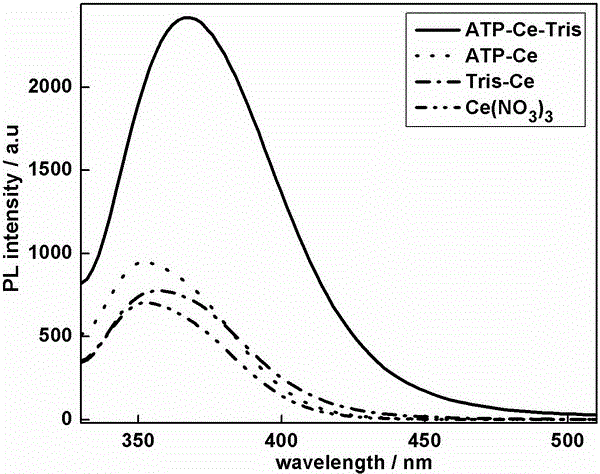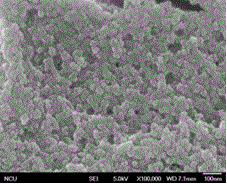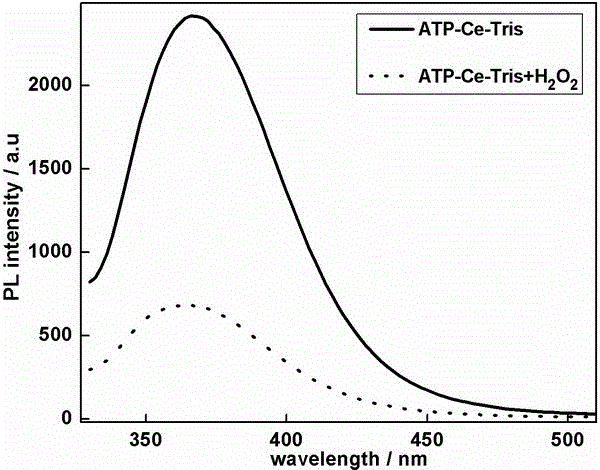Preparation method of rare-earth coordination polymer fluorescence probe and application of rare-earth coordination polymer fluorescence probe in H2O2 and glucose detection
A technology of coordination polymers and fluorescent probes, applied in the field of optical sensing, can solve problems such as rare earth coordination polymer nanoparticles, etc., and achieve high sensitivity and good selectivity.
- Summary
- Abstract
- Description
- Claims
- Application Information
AI Technical Summary
Problems solved by technology
Method used
Image
Examples
Embodiment 1
[0020]Preparation of ATP-Ce-Tris: Mix 0.2 mL of 10 mM adenosine triphosphate (ATP) with 1.6 mL of 50 mM pH 7.4 Tris-HCl buffer solution, and then add 1 mL of 8 mM Ce(NO 3 ) 3 ·6H 2 O aqueous solution was slowly stirred at a rate of 300 rpm / min at room temperature for 1 min to form a white precipitate. The white precipitate was centrifuged at 16000 rpm / min for 15 min, and then washed with ultrapure water. After repeated centrifugation and washing 3 times, the obtained precipitate was dispersed in 2 mL of ultrapure water to prepare ATP-Ce-Tris rare earth complex. Polymeric fluorescent probes.
[0021] ATP-Ce-Tris, ATP-Ce, Ce-Tris and Ce(NO 3 ) 3 Fluorescent properties were characterized, and the results were as follows: figure 1 shown. Under the excitation of light with a wavelength of 310 nm, Ce(NO 3 ) 3 The fluorescence emission peak of the aqueous solution is located at 350 nm; when ATP, Tris and Ce 3+ After mixing, the fluorescence emission peak of the obtained ATP...
Embodiment 2
[0023] Rare earth coordination polymer fluorescent probe for detection of H 2 o 2 and glucose
[0024] (1) Detection of H 2 o 2 : Mix 20 μL of 4 mM ATP-Ce-Tris, 40 μL of 50 mM Tris-HCl pH 7.4 and different concentrations of H 2 o 2 Mix, add ultrapure water to bring the total volume of the test solution to 200 μL, react at room temperature for 25 min, and measure the fluorescence of the solution when the excitation wavelength is 310 nm. Figure 5 a is ATP-Ce-Tris pair H 2 o 2 The detected fluorescence spectrum, along with the H 2 o 2 As the concentration increases, the fluorescent Ce in ATP-Ce-Tris 3+ Gradually H 2 o 2 Oxidized to non-fluorescent Ce 4+ , causing the fluorescence intensity of ATP-Ce-Tris to gradually decrease, and the rate of change of fluorescence intensity of ATP-Ce-Tris (1-F / F 0 ) with H 2 o 2 The logarithm of the concentration has a good linear relationship in the range of 1 nM-80 μM ( Figure 5 b), with a detection limit of 0.6 nM, enabling ...
Embodiment 3
[0027] Examined the ATP-Ce-Tris effect on H 2 o 2 and selectivity for glucose detection ( Figure 7 ). Depend on Figure 7 e Visible, ATP-Ce-Tris for H 2 o 2 During detection, interfering ions include K + , Na + , Ca 2+ , Mg 2+ , PO 4 3- , SO 4 2- , CO 3 2- , Cl - , Ac - etc. No response. Depend on Figure 7 It can be seen from f that when ATP-Ce-Tris detects glucose, the interfering ions include cations (K + , Na + , Ca 2+ , Mg 2+ ) and carbohydrates (lactose (lac), sucrose (suc), fructose (fru), mannose (man)) etc. did not respond. The above results show that the rare earth coordination polymer fluorescent probe ATP-Ce-Tris constructed by the present invention has a positive effect on H 2 o 2 and glucose detection have good selectivity.
PUM
 Login to View More
Login to View More Abstract
Description
Claims
Application Information
 Login to View More
Login to View More - R&D
- Intellectual Property
- Life Sciences
- Materials
- Tech Scout
- Unparalleled Data Quality
- Higher Quality Content
- 60% Fewer Hallucinations
Browse by: Latest US Patents, China's latest patents, Technical Efficacy Thesaurus, Application Domain, Technology Topic, Popular Technical Reports.
© 2025 PatSnap. All rights reserved.Legal|Privacy policy|Modern Slavery Act Transparency Statement|Sitemap|About US| Contact US: help@patsnap.com



